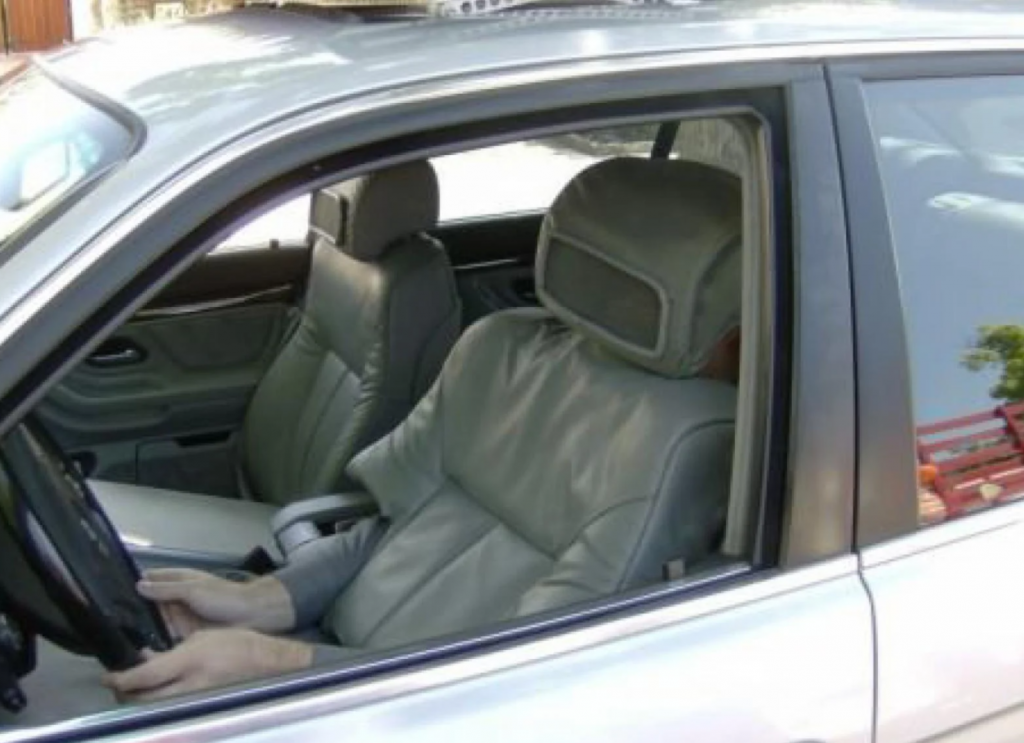The Costume That Was a Trick
Last night, millions of children (and a handful of adults) around the world dressed up in costumes and went door to door asking for candy. And by and large, most of those requests for treats were fulfilled. That’s how Halloween works — lots of costumes, lots of trick-or-treaters, and really, way more candy than anyone should possibly have.
But not all costumes are intended to elicit treats. Some are designed to play tricks on passersby. And in one case, that’s probably a good thing. Here’s a picture (via here) to get us started.

If you don’t see it right away, take a look at the steering wheel — you’ll hopefully notice that there are two hands holding the bottom of it. The person is dressed up as a driver’s seat. As far as trick-or-treating goes, it’s not a great costume; it kind of loses something when you get out of your car to go to your neighbor’s front door. But if you’re trying to scare the you-know-what out of someone, it probably works better than a zombie mask. Imagine you’re a pedestrian and that vehicle drove up next to you. What would you do?
For researchers, that isn’t a rhetorical question. Driverless cars are an increasingly likely part of our collective future, but we won’t get there suddenly. Once these cars are street-ready, adoption will likely be incremental, and not everyone will be expecting to see an automated vehicle sharing the roads with them. So in 2017, Ford, working in conjunction with a team from Virginia Tech’s Transportation Institute, decided to simply put an automated car on the road and see how people reacted. But that would require an already-safe automated car, and that doesn’t exist yet. So they faked it.
The idea was simple — as seen above, the team ripped out the driver seat and replaced them with a costume, and then retrofitted the design of the passenger seat to match. Wendy Ju, a professor at the Jacobs Technion-Cornell Institute at Cornell Tech who ran a similar experiment, told NPR that her version was inspired by “a wonderful YouTube video that shows a person driving through drive-throughs in a car seat costume and just scaring the bejesus out of poor fast food workers.” (Maybe this one. I don’t know, but either way, it really is a wonderful video.) By taking such a stunt to the street, researchers believed they’d get genuine responses. And that can yield a lot of useful data. As Bloomberg CityLab explained, “the experiment was designed to help establish a car-industry standard for a whole new kind of automotive communication: How do we translate the language of nods, waves, honks, and headlight dips that drivers use to assert right-of-way into robot-ese?”
The “driverless” car — actually a white van — drove around Arlington County in northern Virginia for a few days, and people noticed nearly immediately. As word spread, the news tried to get the story, but as one NBC reporter learned, cars don’t typically talk, even when you ask them questions. But the data the “car” was collecting will likely prove valuable. John Shutko, a Ford researcher leading the project, wrote a blog post summarizing the experiment. And the net takeaway may suggest that getting driverless cars on the road is a long way off. While most people who passed by the van weren’t scared, they certainly were curious — but there wasn’t a great way for the car and pedestrians to communicate with one another. People didn’t know how to tell a driverless car what to do, and the diversity of reactions was probably too complicated for a truly driverless car to, at that point, react to properly.
That all said, the question may just be one of data — maybe we just need more. The Ford experiment, per Shutko, “encompasses more than 150 hours and approximately 1,800 miles in a dense urban area,” which is a drop in the bucket. And one automated vehicle tech company, Waymo, has been testing automated vehicles — no costumes needed — for almost a year in San Francisco (but, as Ars Technica reports, with “safety drivers who are ready to intervene if something goes wrong”), so maybe we’re closer than we think. But if not, and if we need to better understand how pedestrians “signal” to a car with no driver, we may see more driverless car costumes in our future.
Bonus fact: For driverless cars to communicate with people, that’s one problem. But what about animals? That’s another set of concerns, as each animal is different, and there are a lot of them. For example, per the Verge, Volvo is confident that their system “has been proven to identify animals like elk and moose” — which is particularly important, because those animals tend to wreck cars that crash into them. But when the Volvo AI was tested in Australia, it didn’t know what to do with kangaroos. Per ABC News Australia, “because the cars use the ground as a reference point, they become confused by a hopping kangaroo, unable to determine how far away it is.” Specifically, Volvo told ABC News, “when it’s in the air it actually looks like it’s further away, then it lands and it looks closer.” As a result, Volvo began working on technology to identify kangaroos and treat them as the special creatures they deserve to be.
From the Archives: The Town That Drives Itself: A city of driverless cars.
